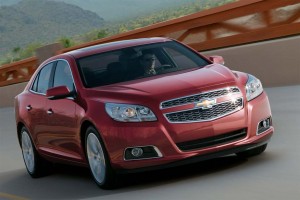
The launch of the new Chevy Malibu is a critical step in transforming the marque into a truly global brand.
It’s been a busy year for Chevrolet – General Motor’s largest brand selling an all-time record 1.1 million vehicles during the first quarter of 2011.
But anyone who still thinks of Chevy as the quintessential American brand, once celebrated with ad slogans that told buyers to “See the USA in your Chevrolet,” might be in for a sobering reappraisal. The brand’s 15% sales gain during the first quarter was largely driven by its increasing presence around the world.
“It’s not an American brand anymore,” suggests Dave Sullivan, automotive analyst with AutoPacific, Inc. “GM has realized that the pie in the U.S. – and the piece Chevy could expect – was too small and they’d have to look elsewhere.”
Coming out of its 2009 bankruptcy, Chevrolet was one of only four North American brands maintained by GM, which sold or closed four others. The challenge has been to hold onto buyers who might have abandoned GM walked away from those familiar marques.
GM has had some success, the surviving siblings picking up many of those customers. Chevy, in particular, saw a 23% gain during the most recent quarter. Even so, the U.S. market accounted for less than four out of 10 of the cars, trucks and crossovers Chevy sold between January 1 and March 31, 416,505 out of that 1.1 million.
The rest came from markets where, until recently, the brand generally had little to no presence. Globally, Chevy was the only top-five automotive brand to gain market share during the quarter – climbing to 5.8% worldwide.
The maker has long been a major force in Latin America – where it is number one in many national markets. Chevy reported mixed results south of the border, however, with a 9% decline in Brazil, the continent’s largest automotive market, but increases of 12% in Mexico and 21% in Argentina.
In recent years, GM has been transforming Chevy from a brand for the Americas into a truly global marque, starting with Europe, where General Motors had traditionally relied on its Opel brand. During the first quarter, demand on the Continent surged 7%, despite overall weak car sales, to 112,482. The brand doubled sales in Denmark and Turkey, and saw increases of more than 50% in France and Russia.
In China, Chevy logged 159,303 sales during the quarter, a bump of 17%. Buick is GM’s dominant brand in what is now the world’s largest automotive market, but Chevrolet was brought in, mid-decade, to help round out the model mix.
Meanwhile, the Chevrolet bowtie emblem is in the midst of its roll-out in Korea, where Chevrolet recently replaced the Daewoo nameplate.
Formally known as GMDAT, the operation had served, over the past decade, as the global center of GM’s small car operations, developing products such as the old Chevy Aveo, its replacement, the new Sonic, and the Spark minicar. In Korea, those and other products were previously marketed as Daewoo but are now getting the bowtie badge.
“The change to Chevrolet will strengthen GM’s presence in the South Korean market,” said Mike Arcamone, president and CEO of GM Korea. “We see great opportunities to contribute to the growth of one of the most iconic global automotive brands.”
Initially, Chevy’s global roll-out focused on Daewoo’s pint-sized econoboxes. But as the brand gains global traction, Chevrolet is reshaping it into a more full-line marque. One of the keys to that will be the launch of the 2012 Malibu, which will be offered in more than 100 countries, about five times as many as the current version of the midsize sedan.
Add in the new Cruze compact, the Chevy Volt plug-in hybrid and other recent products and Chevy’s worldwide network now covers about 54% of the non-luxury segments, the maker claims – and, obviously, more in some markets.
“Our first-quarter results are a clear indication that consumers are responding to our new product line,” suggests Joel Ewanick, GM’s director of global marketing.
Where the brand will go next is uncertain. At one point, shortly after emerging from Chapter 11, it looked like GM would sell off a controlling stake in Opel, which would have almost certainly led the company to put more emphasis on Chevy in Europe and other parts of the world.
For now, with Opel remaining in the fold, Chevrolet is “the other brand” in Europe, where despite impressive growth it still holds only 2.2% of the market.
“They’re doing the right things to create a global brand,” says AutoPacific analyst Sullivan. But “They do have a big perception gap they have to overcome,” he cautions, before Chevy can achieve, worldwide, the dominant role it has long held in the U.S.
